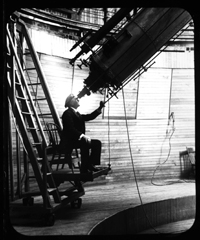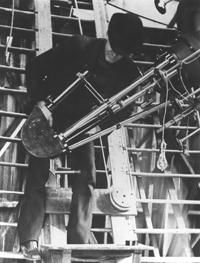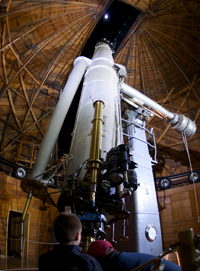The Lowell Observatory launches today a fundraising campaign to restore its famous 24-inch Clark Telescope.

Percival Lowell studies the sky through the 24-inch Clark Telescope.
Lowell Observatory
Today we celebrate Percival Lowell’s 158th birthday. Born in 1855, Lowell was an ambitious thinker whose legacy crosses several fields, including astronomy, Eastern studies, literature, and modern science fiction. Perhaps Lowell’s greatest contributions are the observatory he established and the course of research he set for future generations. The 24-inch Clark refracting telescope has taken part in nearly the entire history of the Lowell Observatory. The facility’s icon connects Lowell’s mission of carrying out astronomical research and sharing the results with the general public.
The Clark Telescope’s resume is quite impressive. It was the primary instrument for Lowell’s provocative studies of Mars. In the early 20th century, V.M. Slipher used the telescope to detect the universe’s expansion. And in the 1960s, scientists and airbrush artists used this telescope to create detailed lunar maps used to aid in the Apollo lunar landing missions.

V.M. Slipher looks through the spectrograph attached to the Clark Telescope.
Lowell Observatory
Over the past several decades, the Clark has been a tool for education, serving an estimated million visitors in the last 20 years, making the Clark a telescope of the people.
With all of this use, the telescope and its housing are wearing down. Typical of instruments of its kind and mechanical devices in general, the Clark Telescope requires regular maintenance — greasing of gears here, tightening of screws there. Longtime instrument maker and telescope caretaker Ralph Nye has ably and lovingly worked his magic to keep the telescope functioning after nightly use for 117 years.
But the relentless march of time catches up with the best of us, both man and machine, and the Clark now needs a major overhaul, including new bearings and gears so that it moves properly, an updated tracking device to accurately follow celestial objects across the skies, a new dome covering to prevent snow from blowing in, and new shutter doors so that Lowell’s lighter-weight staff no longer hang from ropes in an attempt to pry open the heavy coverings.

A father and son look at the Moon through the Clark Telescope in 2011.
Lowell Observatory
This project will cost an estimated quarter of a million dollars. Many of Lowell’s donors and guests, all with personal memories of the telescope, have expressed an interest in helping but don’t have the financial means to make a large contribution. Other groups, such as the Toomey Foundation for the Natural Sciences, are also committed to the cause.
With this widespread interest in the telescope, Lowell decided to launch a two-month long, grass-roots crowd funding campaign to raise $256,718.50. Incentive gifts include pens, posters, t-shirt, and even a laser-etched, acrylic model of the Clark. What better day to kick off such an effort than on March 13, Percival Lowell’s 158th birthday and the 232nd anniversary of William Herschel’s discovery of Uranus.
Click here to contribute to this renovation campaign.
Kevin Schindler is the Outreach Manager and Historian at Lowell Observatory. Take a virtual tour of the Clark with Kevin.
 1
1
Comments
Ari Belenkiy
March 19, 2013 at 1:34 pm
In 1912-1920 V Slipher observed blue- and red-shifts in spectra of galaxies but while suspecting the Doppler effect involved had no clue what the reason for them was. The effect was fully understood only after A Friedman (1922) and G Lemaitre (1927) constructed a new cosmological theory. Additionally, Lemaitre provided for their theory an important test: linearity between radial velocities and distances to the galaxies. The hypothesis was confirmed by E Hubble (1929), using his own distances to the galaxies and Slipher's results slightly corrected by Hubble's collaborator M Humason.
You must be logged in to post a comment.
You must be logged in to post a comment.